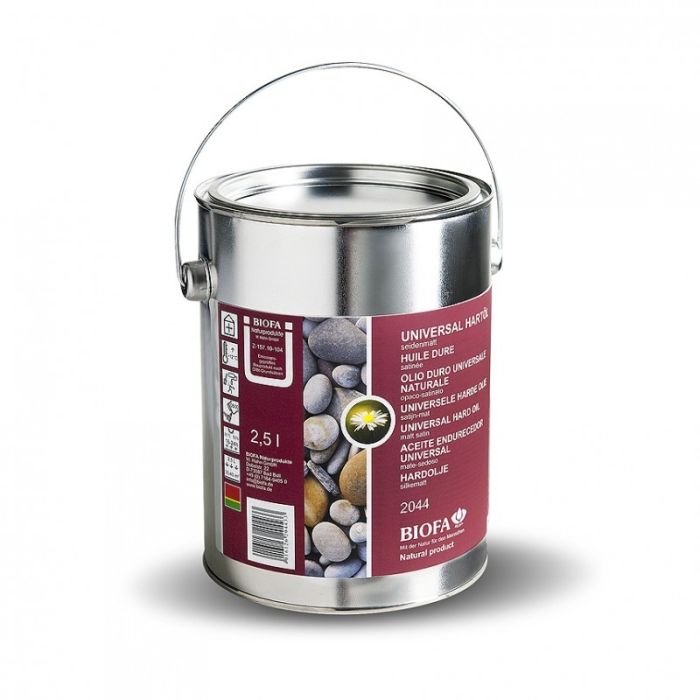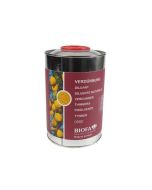Biofa Universal hard oil 2044
Biofa Universal Hard Oil 2044 is suitable for interior absorbent surfaces such as parquet, flooring, cork, linoleum, OSB panels and woodwork.
It's made from 100% natural ingredients, so it's not harmful to your health or to the planet!
- Matte-satin finishing oil
- Does not yellow treated surfaces
- Enhances the natural structure of wood
- Excellent protection
- Water-repellent
- Wear-resistant
Instructions for use
- Substrate preparation: Substrate must be dry (wood moisture content below 12%), clean, free of dust and grease (degrease with BIOFA 0500 thinner if necessary). Remove old paint.
Finish floors with 120-grit abrasive and furniture with 240-grit. - Primer: stir well.
Apply with spalter, roller, spray, dip or cloth in a thin, even coat.
For floors, a short-nap velvet roller is recommended.
Highly porous substrates or woods to be highlighted should be treated with BIOFA 3755 solvent-free, colorless hard primer. A solvent-free undercoat is recommended to reduce the amount of solvent used. - Intermediate coat and finish: intermediate sanding after a first coat of primer 3755 or oil 2044 is recommended (floors 150/180, furniture 240).
Wood or cork floors should be finished with at least two coats of BIOFA 2044 universal hard oil. If hard oil is applied as the only product, depending on porosity, 2 to 3 thin coats are required. The first coat can be applied with a pad, with intermediate sanding if necessary. If the surface is uneven, apply another coat. An even, full-coverage film is required to withstand daily wear and tear.
Important: Mix pots of different fillers before use.
Test beforehand.
During application and drying, ensure good ventilation and air circulation, otherwise an unpleasant odor will develop.
Do not work below 12°C! - Spray application:
Cup: compressed air, 1 to 1.5 mm nozzle, pressure 2 to 2.5 bar.
Airless: 0.23 to 0.28 mm nozzle, pressure 4 bar to 80 bar. - Cleaning of equipment: BIOFA 0500 thinner immediately after use.
- Surface care: dry cleaning with broom, mop or vacuum cleaner.
Wet cleaning: use lukewarm water and a pH-neutral, mild product such as NACASA BIOFA 4010.
See floor care sheet.
Drying
Universal hard oil is dry after 6 to 12 hours and can be recoated and sanded after 16 to 24 hours.
Floors can be walked on with care after 3 days.
Optimum resistance is achieved after 7 to 14 days (20°C / 50 to 55% humidity).
Heat and air circulation promote drying.
Lower temperatures, higher humidity, higher tannin content or exotic wood substrates may result in longer drying times.
Coverage
1st coat: approx. 60-80 ml/m², yield 12-16 m²/liter depending on substrate absorption.
2nd and 3rd coats: 45-60ml/m² or 16 to 20 m²/litre.
Packaging
- 375 ml (5-9m²): €12.14
- 750 ml (10-18m²): €25.04
- 2.5L (30-54m²): €75.51
- 10L (120-220m²): €271.51
Composition
Aliphatic hydrocarbons, castor oil, rosin resin, safflower oil, silicic acid, microcire, montmorillonite, succinic acid, cobalt hexanoate, zirconium and manganese loctoate driers, antioxidant.
Storage
Store in a cool, dry place.
A skin may form on opened containers, which must be removed before re-use. Close containers tightly.
Safety advice
Leave impregnated cloths to dry on non-flammable surfaces (risk of self-ignition), stretch them after soaking in water.
Tent them after soaking in water, or store them in hermetically sealed metal containers. The product is not inherently flammable.
Contains cobaltbis(-ethylhexanoate). May cause allergic reactions.
Natural products should also be kept out of the reach of children.
Do not breathe aerosols.
When heated or sprayed, thinner/air mixtures can be explosive.
Do not breathe vapours.
Use only in well-ventilated areas.
When applying, observe safety rules for skin protection.
Wear a fine dust mask when sanding.
The use of natural raw materials may give off a characteristic odour.
Recycling
Do not dispose of residues down the drain. Liquid product should be disposed of in paint containers or in accordance with local regulations. Small quantities and dry rags can be disposed of in household waste. Empty, dry packaging should be disposed of at a waste disposal center. Unfit packaging should be treated in the same way as the product!
Recycling: Liquid waste - EAK 080111
VOC EU-max. (cat.
A/i) 500 g/L (2010)
BIOFA 2044 contains max ; 490 g/L







